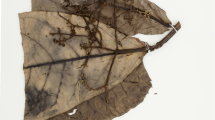Summary
Oxygonum pterocarpum Osborne & Vollesen from West Tanzania is described, illustrated and placed in the context of recent work on the genus in eastern and southern tropical Africa and South Africa. Its ecology, phytogeographical relations and conservation status are discussed. The general paucity of botanical knowledge of the Tabora Region of Tanzania is highlighted.

Similar content being viewed by others
Notes
Connate stipules forming a tube sheathing the stem, commonly found in Polygonaceae.
Tubular sheathing bracts that resemble the ocreae.
References
Brandbyge, J. (1993). Polygonaceae. In: K. Kubitzki, The families and genera of vascular plants. Volume II: 531 – 544. Springer-Verlag, Berlin.
Darbyshire, I. (2008). Notes on the genus Dicliptera (Acanthaceae) in Eastern Africa. Kew Bull. 63: 361 – 383.
Germishuizen, G. (1987). Notes on African plants: Polygonaceae: a new species of Oxygonum from Natal. Bothalia 17 (1): 40 – 41.
____ (1988). Polygonaceae — Reinstatement of Oxygonum acetosella Welw. Bothalia 18 (2): 187 – 188.
____ (1989). Polygonaceae: Oxygonum altissimum, a new species from central Somalia. Bothalia 19 (2): 210 – 211.
Graham, R. A. (1957). A revision of Oxygonum (Polygonaceae–Polygoneae). Kew Bull. 1957: 145 – 172.
____ (1958). Polygonaceae. In: W. B. Turrill & E. Milne-Redhead (eds), Flora of Tropical East Africa, 1 – 40. Crown Agents for Oversea Governments & Administrations, London.
Haraldson, K. (1978). Anatomy and taxonomy in Polygonaceae subfam. Polygonoideae Meisn. Emend. Jaretzky. Symb. Bot. Upsal. 22: 1 – 95.
IUCN (2001). IUCN Red List Categories and Criteria. Version 3.1. IUCN Species Survival Commission, Gland and Cambridge.
Ortiz, S. (2003). Two new species of the Oxygonum stuhlmannii-atriplicifolium complex (Polygonaceae) from Somalia. Bot. J. Linn. Soc. 142: 341 – 345.
____ & Paiva, J. A. R. (1999). Taxonomic notes on Polygonaceae from southern tropical Africa. Bot. J. Linn. Soc. 131: 167 – 176.
Nogueira, I., Ortiz, S. & Paiva, J. A. R. (2006). Polygonaceae. In: G. V. Pope, R. M. Polhill & E. S. Martins (eds), Flora Zambesiaca. Flora Zambesiaca Managing Committee, London.
Schuster, T. M., Reveal, J. L. & Kron, K. A. (2011). Phylogeny of Polygoneae (Polygonaceae: Polygonoideae). Taxon 60: 1653 – 1666.
Takhtajan, A. L. (2009). Flowering Plants. 2nd edn, p. 155. Springer, Berlin.
UNdata (2014). http://data.un.org/CountryProfile.aspx?crName=United+Republic+of+Tanzania
White, F. (1983). The vegetation of Africa. Natural Resources Research XX. Unesco, Paris.
Acknowledgements
The authors are grateful to The Tanzania Commission for Science and Technology (COSTECH) for granting the Research Clearances which allowed the collecting trips in 2006, 2008 and 2009 to be carried out. Also to The National Herbarium of Tanzania at TPRI, Arusha for allowing Godson Leliyo to accompany us on these trips. As ever Godson was diligent and hardworking and always a cheerful companion during our various travails on these trips. We are also grateful to Juliet Williamson for her excellent illustration.
Author information
Authors and Affiliations
Corresponding author
Rights and permissions
About this article
Cite this article
Osborne, J., Vollesen, K. & Darbyshire, I. Oxygonum pterocarpum (Polygonaceae), a striking new species from the Tabora Region of Tanzania. Kew Bull 70, 21 (2015). https://doi.org/10.1007/s12225-015-9574-9
Accepted:
Published:
DOI: https://doi.org/10.1007/s12225-015-9574-9




